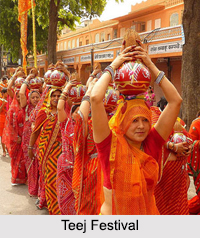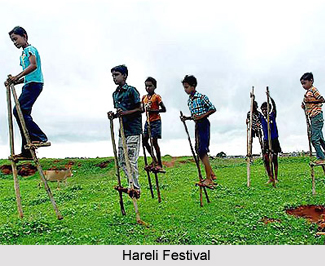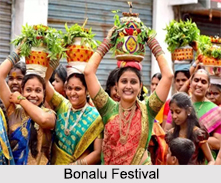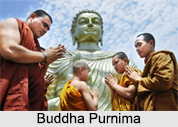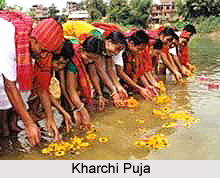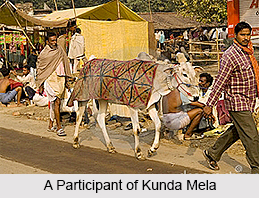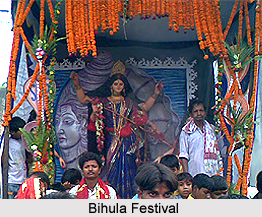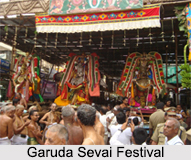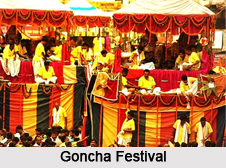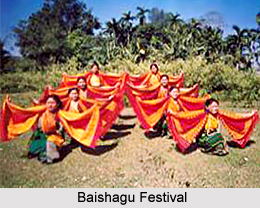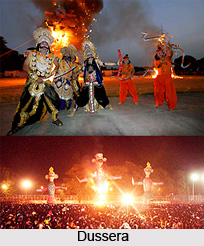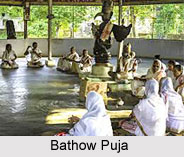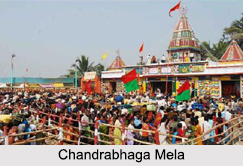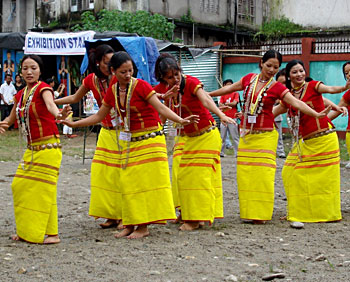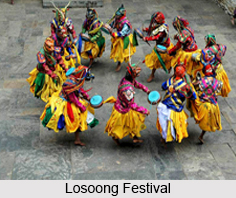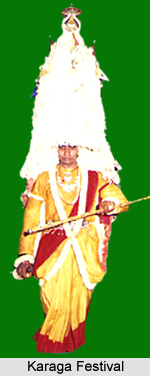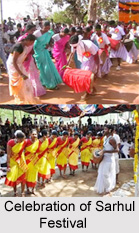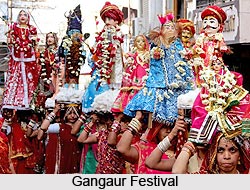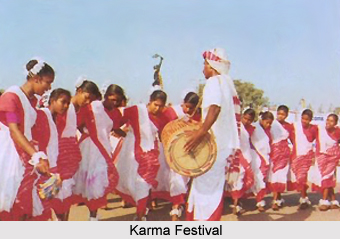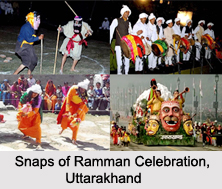 Ramman is an Indian religious festival manifested in the form of ritual theatre, held annually in the Garhwal region of the mountainous state of Uttarakhand. It is celebrated by the Hindu community of the Saloor-Dungra twin villages of the Painkhanda Valley in the Chamoli district of the state. It is an endangered art form, being performed as a religious offering to the village deity, Bhumiyal Devta, in the courtyard of the village temple. Ramman is unique to the village and is neither replicated nor practised anywhere else in the Himalayan region. It is also specific to the time when it is held, commencing either on the 9th or the 11th day after Baisakhi, in late April.
Ramman is an Indian religious festival manifested in the form of ritual theatre, held annually in the Garhwal region of the mountainous state of Uttarakhand. It is celebrated by the Hindu community of the Saloor-Dungra twin villages of the Painkhanda Valley in the Chamoli district of the state. It is an endangered art form, being performed as a religious offering to the village deity, Bhumiyal Devta, in the courtyard of the village temple. Ramman is unique to the village and is neither replicated nor practised anywhere else in the Himalayan region. It is also specific to the time when it is held, commencing either on the 9th or the 11th day after Baisakhi, in late April.
In 2009, the UNESCO inscribed Ramman on its Representative List of the Intangible Cultural Heritage of Humanity.
Deity worshipped in Ramman
Ramman is celebrated in religious devotion to the protector deity of Saloor-Dungra, Bhumichetrapal, also known as Bhumiyal Devta. The festive is held in her honour every year after Baisakhi, a harvest festival that also marks the beginning of the Hindu Solar New Year. On the day of Baisakhi, the village priest announces the date for the Ramman celebration, which falls either on the 9th or the 11th day after Baisakhi. Bhumiyal Devta comes out in a procession to the village temple, on the day of Baisakhi. The second day after Baisakhi, people of the village offer "hariyali" (sprouted barley plants), to the deity who, in turn, promises prosperity to all, including agricultural yield and forest produce. Every day of the festival, the deity takes a round of the village. The festival lasts for ten days, during which time the local epic of Lord Rama is sung and masked dances depicting different aspects of everyday life are enacted in the courtyard of Bhumiyal Devta`s temple.
Festivities and Dances in Ramman
The celebration of Ramman is made up of highly complex rituals: the recitation of a version of the epic of Rama and various legends, along with the performance of songs and masked dances. The festivities begin with an invocation to Lord Ganesha, the remover of obstacles, followed by the dance of Ganesha and Parvati. This is followed by the dance of the Sun God, an enactment of the creation-myth of the birth of Brahma and Ganesha. The other dances include the dance of the Bur Deva along with Gopi Chand (Krishna) and Radhika, the Mwar-Mwarin dance that showcases the travails of the buffalo herders and the Baniya-Baniyain Nritya, which is the dance of the trader couple that displays the hardships faced by the common people. After these initial performances, the focus now shifts to the enactment of the local Rama Katha - episodes from Lord Rama"s life beginning with his visit to Janakpur and culminating with his coronation following his return from exile, all being sung to a total of 324 beats and steps. Another important facet of these performances is the singing of Jagar, a musical rendition of local legends. There are also other dances and episodes like Maal Nritya, Koorjogi and Narsingh Pattar Nritya, which follow the Rama Katha. In the Maal Nritya, a historical battle between the Gurkhas of Nepal and the local Garhwalis is comically enacted by a troupe of four dancers dressed in red and white. It is mandatory to have a red Maal from the Kunwar caste of the Saloor village, as the hamlet is believed to have had supported the Gurkhas, while the other three are selected by the Pancha panel of the Gram Panchayat. In the Koorjogi ceremony, weeds ("koor") from the village fields are pulled out by a Koorjogi, the character who carries a sack full of these weeds. There is much merriment as people throw these weeds at each other in a spirit of a communal sport.
All these performances are meant not only to propitiate the deities, but the deities themselves actually appear as a part of the dramatis personae in the performances, with specific roles. Ramman also bears a clear link with the historical memory of the community, which is enacted in the Maal Nritya.
Community Participation in Ramman
The celebration of Ramman is a community practice and the villagers of Saloor-Dungra are the inheritors, organizers and financers of the festival. All households, irrespective of the caste, community and occupational group, have a distinct role to play in Ramman, in offering prayers and performing rituals to the principal deity. The roles of the various castes in the festival, are however, well established. Talented youth and elders selected by the village heads are the performers at Ramman, while the Brahmin priests conduct the rituals and prepare and serve "prasada" to the deity. The Bhandaris, representing locals of the Kshatriya caste, are alone entitled to wear one of the most sacred masks, that of the half-man and half-lion Hindu deity, Narasimha. The Baaris are charged with the organisation and collection of funds while the Dhaaris are a group that assists the Baaris in organizing the event. The Baaris and the Dhaaris are assigned their duties by the Gram Pancha panel. It is also them who select the residence of Bhumiyal Devta till the next Ramman festival. The family where Bhumiyal Devta resides for the year has to maintain a strict daily routine and a place in the house is demarcated and consecrated for the deity. The Jagar is sung by the Jagaris or Bhallas of the Rajput caste, who are professional bards. The playing of drums is central to the festivities and is done by the drummers of the Das community, the lowest caste, whose status gets elevated during their performance. The celebration of Ramman ends with a feast where the “prasada†of the deity is distributed as a sacrament.
Ramman being a threatened unique tradition
Ramman combines the sacred, social and ritualistic with revelry and expresses the history, faith, lifestyle, fears and hopes of the Saloor Dungra villagers through a mesh of oral, literary, visual, kinetic and traditional craft forms, alongside dance, singing and drumming performances in the festivities. Ramman is an annual affair that children learn by watching. The various skills it involves in terms of performing arts and traditional oral and written tales are passed down across hereditary communities orally. The onslaught of globalization and technology and lack of financial or artistic compensation have, however, adversely affected the ritual and traditional performances of this multiform cultural event. Being peripheral to the mainstream art forms, the awareness of Ramman beyond its immediate borders is small and therefore, it stands the risk of becoming extinct in time. In order to ensure that the village tradition remains viable, the community`s priorities are to promote its transmission and to obtain its recognition beyond the geographical area in which it is practised.
Related Articles:
Indian Religious Festivals
Hindu Festivals
Ritual Theatre in India
Garhwal Division
Uttarakhand
Festivals of Uttarakhand
Fairs and Festivals of Chamoli District
Lord Rama
